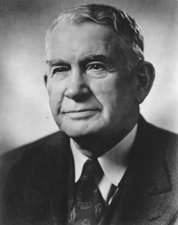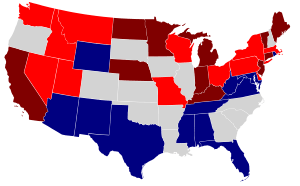United States Senate elections, 1946
| | ||||||||||||||||||||||||||||||||||||||||||||||||||||||||||||||||||||||||||||||
| ||||||||||||||||||||||||||||||||||||||||||||||||||||||||||||||||||||||||||||||
| ||||||||||||||||||||||||||||||||||||||||||||||||||||||||||||||||||||||||||||||
|
| ||||||||||||||||||||||||||||||||||||||||||||||||||||||||||||||||||||||||||||||
| Republican holds
Republican gains
Democratic holds | ||||||||||||||||||||||||||||||||||||||||||||||||||||||||||||||||||||||||||||||
| ||||||||||||||||||||||||||||||||||||||||||||||||||||||||||||||||||||||||||||||
The United States Senate elections of 1946 were in the middle of Democratic President Harry Truman's first term.
The Republicans took control of the Senate by picking up twelve seats, mostly from the Democrats.
The vote was largely seen as a referendum on Truman, whose approval rating had sunk to 32% over the president's controversial handling of a wave of post-war labor strikes, such as a nationwide railroad strike in May, at a time when Americans depended on train service for both commuter and long-distance travel. Just as damaging was Truman's back-and-forth over whether to end unpopular wartime price controls to handle shortages, particularly in foodstuffs. For example, price controls on beef had led to a "hamburger famine", but when Truman, in a surprise move, lifted the controls on October 14 — just weeks before the election — meat prices shot up to record levels.
Change in Senate composition
Senate composition before the elections
| D8 | D7 | D6 | D5 | D4 | D3 | D2 | D1 | ||
| D9 | D10 | D11 | D12 | D13 | D14 | D15 | D16 | D17 | D18 |
| D28 | D27 | D26 | D25 | D24 | D23 | D22 | D21 | D20 | D19 |
| D29 | D30 | D31 | D32 | D33 | D34 | D35 | D36 | D37 | D38 |
|---|---|---|---|---|---|---|---|---|---|
| D48 | D47 | D46 | D45 | D44 | D43 | D42 | D41 | D40 | D39 |
| D49 | ← Majority | ||||||||
| D50 | D51 | D52 | D53 | D54 | D55 | D56 | P1 | R39 | |
| R29 | R30 | R31 | R32 | R33 | R34 | R35 | R36 | R37 | R38 |
| R28 | R27 | R26 | R25 | R24 | R23 | R22 | R21 | R20 | R19 |
| R9 | R10 | R11 | R12 | R13 | R14 | R15 | R16 | R17 | R18 |
| R8 | R7 | R6 | R5 | R4 | R3 | R2 | R1 | ||
Senate composition as a result of the elections
| D8 | D7 | D6 | D5 | D4 | D3 | D2 | D1 | ||
| D9 | D10 | D11 | D12 | D13 | D14 | D15 | D16 | D17 | D18 |
| D28 | D27 | D26 | D25 | D24 | D23 | D22 | D21 | D20 | D19 |
| D29 | D30 | D31 | D32 | D33√ | D34√ | D35√ | D36√ | D37√ | D38√ |
|---|---|---|---|---|---|---|---|---|---|
| R49+ | R50+ | R51+ | D45O | D44O | D43O | D42O | D41√ | D40√ | D39√ |
| ← Majority | |||||||||
| R48+ | R47+ | R46+ | R45+ | R44+ | R43+ | R42+ | R41+ | R40+ | R39O |
| R29√ | R30√ | R31√ | R32√ | R33√ | R34√ | R35O | R36O | R37O | R38O |
| R28√ | R27 | R26 | R25 | R24 | R23 | R22 | R21 | R20 | R19 |
| R9 | R10 | R11 | R12 | R13 | R14 | R15 | R16 | R17 | R18 |
| R8 | R7 | R6 | R5 | R4 | R3 | R2 | R1 | ||
| Key: |
|
|
|---|
Republican wave
The president's lack of popular support is widely seen as the reason for the Democrats' congressional defeat, the largest since they were trounced in the 1928 pro-Republican wave that brought Herbert Hoover to power. And for the first time since before the Great Depression, Republicans were seen as the party which could best handle the American economy.
However, the Republicans also benefited from what today would be called "a good map," meaning that of the one-third of Senate seats up for election, the majority were held by Democrats.
Besides the Republicans being able to hold onto all of their seats, this was the party's largest senate gain since 1920.
Gains and losses
In addition to a net Republican gain by appointment before the election, the Republicans picked up twelve seats, eleven of them from Democrats, and one from Progressive Robert M. La Follette, Jr. (P-WI). This gave them a Senate majority for the first time since Hoover's administration. This election is also notable for the election of Joe McCarthy who would become famous for his investigations of communism in the 1950s.
In addition to capturing open seats in Idaho, Montana, Nevada, and New York, the Republicans defeated seven Democratic incumbents:
- James M. Tunnell (D-DE)
- David I. Walsh (D-MA)
- Frank P. Briggs (D-MO), seat was previously held by President Truman himself.
- James W. Huffman (D-OH)
- Joseph F. Guffey (D-PA)
- Abe Murdock (D-UT)
- Hugh B. Mitchell (D-WA)
Complete list of races
| State | Incumbent | Party | Result | Opposing Candidates |
|---|---|---|---|---|
| Alabama Special: Class 2 |
George R. Swift | Democratic | Appointee retired when successor elected to finish term Democratic hold |
John Sparkman (Democratic) unopposed |
| Arizona | Ernest W. McFarland | Democratic | Re-elected | Ernest W. McFarland (Democratic) 69.2% Ward S. Powers (Republican) 30.1% |
| California | William F. Knowland | Republican | Re-elected | William F. Knowland (Republican) 54.1% Will Rogers, Jr. (Democratic) 44.2% |
| Connecticut | Thomas C. Hart | Republican | Retired Republican hold |
Raymond E. Baldwin (Republican) 56.1% Joseph M. Tone (Democratic) 40.7% |
| Delaware | James M. Tunnell | Democratic | Lost re-election Republican gain |
John J. Williams (Republican) 55.2% James M. Tunnell (Democratic) 44.9% |
| Florida | Spessard Holland | Democratic | Re-elected | Spessard Holland (Democratic) 78.7% J. Harry Schad (Republican) 21.4% |
| Idaho Special: Class 2 |
Charles C. Gossett | Democratic | Appointee lost nomination to finish term Republican gain |
Henry C. Dworshak (Republican) 58.6% George E. Donart (Democratic) 41.4% |
| Indiana | Raymond E. Willis | Republican | Retired Republican hold |
William E. Jenner (Republican) 52.4% M. Clifford Townsend (Democratic) 46.8% |
| Kentucky Special: Class 2 |
William A. Stanfill | Republican | Appointee retired when successor elected to finish term Republican hold |
John S. Cooper (Republican) 53.3% John Y. Brown (Democratic) 46.5% |
| Maine | Ralph O. Brewster | Republican | Re-elected | Ralph O. Brewster (Republican) 63.6% Peter M. MacDonald (Democratic) 36.5% |
| Maryland | George L. P. Radcliffe | Democratic | Lost renomination Democratic hold |
Herbert R. O'Conor (Democratic) 50.2% David J. Markey (Republican) 49.8% |
| Massachusetts | David I. Walsh | Democratic | Lost re-election Republican gain |
Henry Cabot Lodge, Jr. (Republican) 59.6% David I. Walsh (Democratic) 39.7% |
| Michigan | Arthur H. Vandenberg | Republican | Re-elected | Arthur H. Vandenberg (Republican) 67.1% James H. Lee (Democratic) 32.0% |
| Minnesota | Henrik Shipstead | Republican | Lost renomination Republican hold |
Edward John Thye (Republican) 58.9% Theodore Jorgenson (Democratic) 39.8% |
| Mississippi | Theodore G. Bilbo | Democratic | Re-elected | Theodore G. Bilbo (Democratic) unopposed |
| Missouri | Frank P. Briggs | Democratic | Lost re-election Republican gain |
James P. Kem (Republican) 52.7% Frank P. Briggs (Democratic) 47.1% |
| Montana | Burton K. Wheeler | Democratic | Lost renomination Republican gain |
Zales N. Ecton (Republican) 53.5% Leif Erickson (Democratic) 45.4% |
| Nebraska | Hugh Butler | Republican | Re-elected | Hugh Butler (Republican) 70.8% John E. Mekota (Democratic) 29.2% |
| Nevada | Edward P. Carville | Democratic | Lost renomination Republican gain |
George W. Malone (Republican) 55.2% Berkeley L. Bunker (Democratic) 44.8% |
| New Jersey | H. Alexander Smith | Republican | Re-elected | H. Alexander Smith (Republican) 58.5% George E. Brunner (Democratic) 40.1% |
| New Mexico | Dennis Chavez | Democratic | Re-elected | Dennis Chavez (Democratic) 51.5% Patrick J. Hurley (Republican) 48.5% |
| New York | James M. Mead | Democratic | Retired Republican gain |
Irving M. Ives (Republican) 52.6% Herbert H. Lehman (Democratic) 47.6% |
| North Dakota | William Langer | Republican | Re-elected | William Langer (Republican) 53.3% Arthur E. Thompson (Independent) 23.5% Abner B. Larson (Democratic) 23.2% |
| North Dakota Special: Class 3 |
Milton R. Young | Republican | Appointee elected to finish term | Milton R. Young (Republican) 55.5% William Lanier (Democratic) 27.4% Gerald P. Nye (Independent) 15.2% |
| Ohio | James W. Huffman | Democratic | Lost re-election Republican gain |
John W. Bricker (Republican) 57.0% James W. Huffman (Democratic) 42.4% |
| Pennsylvania | Joseph F. Guffey | Democratic | Lost re-election Republican gain |
Edward Martin (Republican) 59.3% Joseph F. Guffey (Democratic) 39.8% |
| Rhode Island | Peter G. Gerry | Democratic | Retired Democratic hold |
J. Howard McGrath (Democratic) 55.1% W. Gurnee Dwyer (Republican) 44.9% |
| Tennessee | Kenneth D. McKellar | Democratic | Re-elected | Kenneth D. McKellar (Democratic) 66.6% W. B. Ladd (Republican) 26.2% |
| Texas | Tom Connally | Democratic | Re-elected | Tom Connally (Democratic) 88.5% Murray C. Sells (Republican) 11.5% |
| Utah | Abe Murdock | Democratic | Lost re-election Republican gain |
Arthur V. Watkins (Republican) 51.2% Abe Murdock (Democratic) 48.8% |
| Vermont | Warren R. Austin | Republican | Retired Republican hold |
Ralph E. Flanders (Republican) 74.6% Charles P. McDevitt (Democratic) 25.4% |
| Virginia | Harry F. Byrd | Democratic | Re-elected | Harry F. Byrd (Democratic) 64.9% Lester S. Parsons (Republican) 30.5% |
| Virginia Special: Class 2 |
Thomas G. Burch | Democratic | Appointee retired when successor elected to finish term Democratic hold |
A. Willis Robertson (Democratic) 68.2% Robert H. Woods (Republican) 29.0% |
| Washington | Hugh B. Mitchell | Democratic | Lost re-election Republican gain |
Harry P. Cain (Republican) 54.3% Hugh B. Mitchell (Democratic) 45.2% |
| West Virginia | Harley M. Kilgore | Democratic | Re-elected | Harley M. Kilgore (Democratic) 50.3% Thomas Sweeney (Republican) 49.7% |
| Wisconsin | Robert M. La Follette, Jr. | Progressive | Lost renomination as a Republican Republican gain |
Joseph R. McCarthy (Republican) 61.3% Howard J. McMurray (Democratic) 37.4% Edwin Knappe (Socialist) 1.2% |
| Wyoming | Joseph C. O'Mahoney | Democratic | Re-elected | Joseph C. O'Mahoney (Democratic) 56.2% Harry B. Henderson (Republican) 43.8% |
See also
References
| ||||||||||


